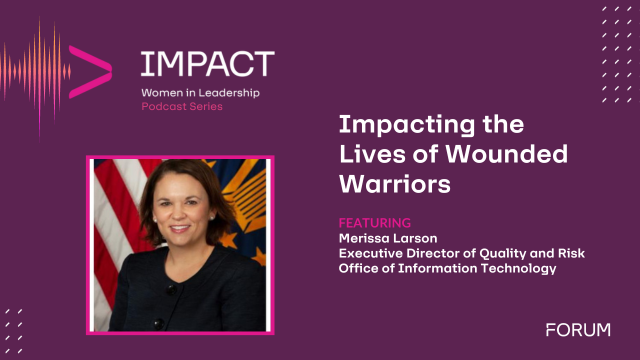Kevin Seeley, former deputy CIO at DHA, recently shifted from a hands-on Military career to GDIT as Vice President of Strategic Programs, Military Health. With his vast experience and a few months under his belt at GDIT, Kevin dives into the past, present, and future of his career sharing his lessons learned and experience.
As DHA’s Deputy CIO, you oversaw an $11B HIT portfolio. What are some of the challenges you experienced when coordinating technology programs across a large enterprise, and how were you able to overcome them?
As you can imagine, the size and scope of DHA’s IT operations was daunting. With any large organization, challenges usually originate in silos or stovepipes of operations that may not always see their common mission, or how their individual operations could improve communication across interdependencies. I overcame these by prioritizing, sensing, listening, and talking with the entire team. I found myself often diffusing fear of IT and championing efforts to bring teams together to support one another and to rally them to a common vision and purpose.
What innovations have you seen in HIT throughout your career? How have these technology advances improved the health and wellbeing of our service members?
IT has come a long way, especially since I was a medic. For Military Health, the pandemic in particular elevated telemedicine to new heights. Implementing virtual remote and on-demand care to Service Members helped keep the force on the job defending our nation. I’ve seen springboard advancements in analytics, informatics, and data science that put new insights and knowledge into the hands of Military care providers faster resulting in readily available services for Military Members. This has enabled providers to make better informed clinical decisions and improved their ability to educate the Military force population on healthy practices and optimize readiness.
What emerging technology excites you the most when it comes to impacting Military Healthcare and HIT?
I’m most excited about the confluence of existing and emerging technologies. A very complex Military mission, and all its scenarios, requires a rapid transfer and integration of technologies from across the Government, academic, and industry ecosystem and to rapidly deploy and mature them for Military Healthcare operations, from the point of care and forward edge of the battlefield, to in-garrison and headquarters operations. The convergence of cloud, AI, 5G, and interoperable data standards has brought additional speed, value, and relevance to fast paced warfighting – this excites me, in particular, where applying innovative results of research and development to the art of the possible becomes reality. This is a big part of GDIT’s philosophy. Our culture of continuous innovation is a big reason I’m excited to be in a position to help build strategy for Military and Veteran Health customers.
What do you see as the greatest need in HIT right now? What recommendations do you have to fill that need?
This may not sound like a technology answer, but “trust” is really what’s needed – we’ve got to come to grips with the tension between technology and users that’s almost palpable. Regardless of the choices that exist, if we insert technologies into the Healthcare environment and the patient care experience, those technologies must work reliably for the user, clinician, and patient. Hassle-free workflow integration in the solutions that are delivered is critical to user adoption and building trust through achieving the promises of IT. IT must work for the user, not the other way around.
Regarding workflows, I’ll add that I’ve now had the opportunity to witness GDIT’s employees and staff commitment to understanding customer workflows and exact needs, and integrate those requirements quickly. I would use a term “agile.” When I think of agile, it’s not just a software development methodology, but it’s also agility in responsiveness to the customer. At GDIT, it’s not just talking about agility, it’s about pursuing agility every day.
What challenges do you see coming up on the horizon?
There’s never a shortage of challenges. My personal motto has always been, “act local, think enterprise-wide.” With the changes at DHA, and reduced budgets across the Government there will be ongoing challenges. Everybody needs to be serious about working arm in arm with the Government customers – understanding where they are modernizing and helping them quickly evolve to achieve their envisioned capabilities and desired outcomes.
With a distinguished Service career spanning over 20 years in Military Healthcare, how will your experience help fulfill GDIT’s mission of providing support and promoting the health of our those who serve our country?
I started my Military career as a hands-on U.S. Air Force medic in the early 1990s, and since then, I’ve used my Military skills and leadership experience to cultivate and lead digital transformation across the joint Military Health environment.
I’m striving to champion innovation at GDIT. I’ll continue to seek and introduce new and creative ways to build and sustain trust to help Defense achieve its objectives. I want to showcase GDIT’s depth and breadth across Defense and beyond, and bring GDIT’s tremendous capabilities and innovation to the table to demonstrate that GDIT is, and will always be, a trusted partner in the evolution of Military Health care delivery, Defense Health, and across all Federal health customers.
What key lessons have you learned during your years of Military Service, your work in HIT, and as an affiliate of the American College of Healthcare Executives?
Always 1) be ready for the unexpected and 2) make required adjustments quickly. Personally, and professionally, I believe a big lesson every Healthcare leader learns is that “the actual customer, provider, patient experience doesn’t always reflect what leadership thinks it is.” It’s incumbent on leadership to communicate intent, validate the data, and revalidate that the organization and its people are producing desired outcomes for those they serve – Healthcare leaders must be open and willing to listen, make adjustments, and have the courage to communicate where change is needed.
You have received numerous awards and recognition throughout your Military career. What is the one accomplishment you are most proud of, and why?
I think awards and recognition are great snapshots and reminders of our past personal accomplishments and the things that shape us into the future. Each has helped me build confidence and forward momentum, especially as I reflect on the failures in-between. The ones that are the most meaningful to me, however, are the team awards and those received in leadership positions that bolstered momentum and long-term pride in the organization, its purpose, and its mission. Overall, being selected as the Deputy Chief Information Officer of the Defense Health Agency (DHA) allowed me to be in a position to facilitate change and transformation, and lead evolution across Defense and Health. My proudest accomplishment was being able to help transform the Military Health System.
As you transition to the civilian working environment, what are you looking forward to the most?
Coming over from the DHA as a Military Member, I look forward to broadening my knowledge and understanding of the work that goes on outside the Government to support our nation, and the health and wellness of our Military Members and Veterans – while simultaneously applying my experience and knowledge to facilitate results as we move forward together.
About Kevin Seeley (Ret COL)
Kevin Seeley is Vice President for Strategic Programs in the Federal Health Sector at General Dynamics Information Technology. In this role, he oversees growth projects supporting the Military Health System (MHS) and strategic opportunities for collaboration across Federal Health.
Prior to joining GDIT, Seeley was a Colonel in the U.S. Air Force, most recently serving as MHS Deputy Chief Information Officer (CIO) and Deputy Director, J6 Health IT, Defense Health Agency (DHA). In this role, he led the U.S. Armed Forces Health IT, executing an $11B portfolio supporting 699 military treatment facilities worldwide. Previous roles during his decorated career include Chief, DHA Infrastructure and Operations Division; Chief Technology Officer, Office of the Surgeon General, Headquarters U.S. Air Force; Chief Operating Officer, DHA J6 Health IT Business Support Branch; CIO, Air Force Medical Operations Agency, and Commander, 7th Medical Support Squadron.
Seeley was named Federal Health IT Leader of the Year in 2018 by Healthcare Information and Management Systems Society (HIMSS); Department of Defense CIO Team of the Year in 2017; and has received numerous commendations and medals during his service. He is also active in HIMSS, serving previously as National Federal Health Community Chair for the Washington, D.C., chapter, and President of the Nevada chapter.
Seeley earned a bachelor’s degree in Computer Information Systems from Park University, Missouri; Master of Business Administration from the University of Colorado, Boulder; and a Health Executive Leadership Certificate from the University of California, San Diego. He is a member of the American College of Healthcare Executives and a Certified Professional and Fellow with HIMSS.












